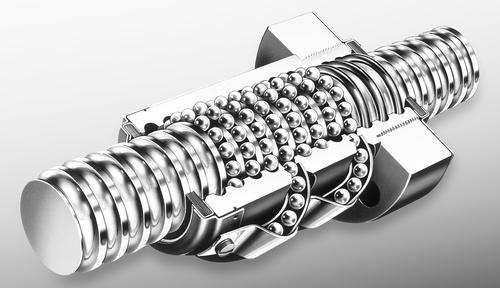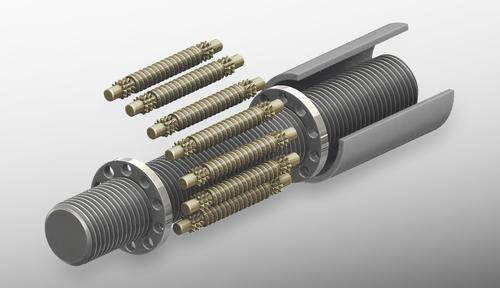Motion engineering quiz: If you need to actuate a 500 kN axial load along a 1,500 mm stroke, do you use a roller screw or a ball screw?
January 27, 2016
If you reflectively said roller screw, you may not be familiar with high-capacity ball screws as an economical and simplified alternative. Roller screws are understood as the linear actuation technology of choice for handling large loads when size is a constraint, but advances in ball screw technology make special versions viable candidates for high-load applications. This is important because a high-load ball screw is typically less than half the cost of a comparable roller screw at equivalent performance points.
What’s the Difference?
A ball screw (Figure 1) consists of a threaded metal shaft with a nut that rides along its length as a motor rotates the shaft. The nut connects to a table, an arm, or other load as determined by the industrial process that is being automated. Recirculating ball bearings packaged within the nut contact the threads and provide the load-bearing path.

Figure 1: Ball screw.
(Source: Thomson Industries)
The coefficient of friction between the mating components is low, which provides a system efficiency of greater than 90% typically. The load capacity of the ball screw is a function of the ball bearing diameter, number of ball bearings, and surface contact area. The load capacity of the assembly, in turn, determines the resultant life of the components.
For higher loads, design engineers have specified roller screws (Figure 2) in many applications. In a roller screw, the load-bearing mechanism is a set of recirculating rollers instead of balls. The rollers have more total surface contact area than balls, which increases the load-carrying capacity and can increase service life.

Figure 2: Roller screw.
(Source: Thomson Industries)
But these benefits come at premium. Compared to the relatively simple, time-tested ball screw system, roller screws require extensive upfront precision machining and more complex assembly. This contributes to the overall higher cost of roller screws, as well as a larger installation footprint.
Characteristics of a High-Load Ball Screw
A high-load ball screw (Figure 3) uses a thread form in the screw and nut that increases its load-bearing capacity by four to eight times over traditional ball screws. Requiring stricter manufacturing techniques, a high-load ball screw, using this thread form, achieves a greater contact area between components, which equates to higher load capacity. The contact stress is the limiting factor on ball bearings, and stress is defined by load per surface area. Increasing the surface area lowers the contact stress and raises the load capacity.

Figure 3: High-load ball screw.
(Source: Thomson Industries)
This gives the design engineer the option of deploying a ball screw in almost any roller-screw application. Or, since the life of the motion assembly is a direct function of the load capacity, using a high-load ball screw in a low-load application would extend the life of the system.
Consider an automotive equipment assembly application that is running 24/7 a load of 100 kN. Based on the standard life calculation, the product may last three to four months, according to the fatigue failure analysis and statistical life expectancy. Implementing a high-load ball screw would double the load capacity and yield eight times the life. So the manager of each production unit has the option of going for higher load capacity, longer assembly life, or the combination of both.
[Learn more automation & control trends and developments at Pacific Design & Manufacturing, Feb. 9-11, at the Anaheim Convention Center.]
Taking another example, an injection molding application might require 400 kN of force over 500 mm, for which a designer might traditionally specify a roller screw. But that high force is required only for maybe the last 10 mm, when the mold is being compressed. The user is paying a premium for high load across the full stroke. By deploying a high-load ball screw, though, the designer gets the needed power at the final 10 mm, while additional load-bearing potential factors into extended life for the system. A roller screw is also capable of satisfying this application but has a nut that is close to 50% larger and cost 150% greater than that of a comparable high-load ball screw.
A New High-Load Alternative
Specifying high-load ball screws in applications previously relegated to roller screws can save money, extend product life, or do both. Any new application will require careful analysis of load capacity, product life, and cost. There may still be some applications where roller screws are better suited than high-load ball screws. But given new ball screw technology advances that increase load-bearing capacity, it is now wise to consider high-load ball screws in any application for which you might now be considering a roller screw.
Jeff Johnson is global product line manager for screws at Thomson Industries Inc. He has worked in linear motion for 20 years, with the last eight dedicated to screw technology.
Like reading Design News? Then have our content delivered to your inbox every day by registering with DesignNews.com and signing up for Design News Daily plus our other e-newsletters. Register here!
You May Also Like



